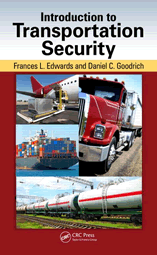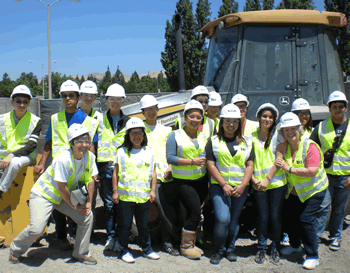- 408-924-7560
- mineta-institute@sjsu.edu
- Donate
Newsletter Winter 2012: Vol. 19, Issue 3
Consortium’s first year: progress and changes
Rod Diridon, Executive Director
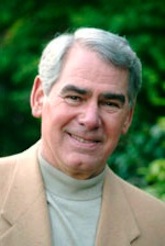
MNTRC to host TRB high-speed rail workshop
As a unique declaration of confidence in the Mineta National Transit Research Consortium (MNTRC), the National Research Council's Transportation Research Board (TRB) has asked the Consortium to arrange a full day of high-speed rail programing on Sunday, January 13, the first day of the annual TRB Congress in Washington DC. The event convenes at 8:30 a.m. and adjourns at 5:00 p.m. in the Omni Shoreham's Blue Room. It promises to be standing room only for this charismatic subject.
Transportation secretary LaHood to keynote
US DOT Secretary Ray LaHood will keynote, and Deputy Federal Railroad Administrator Karen Hedlund will be a lead moderator for the six panels showcasing the worlds' top experts on the subject. Reservations may be made via the TRB web site.
With President Obama and other national leaders like California’s Governor Jerry Brown determined to implement a high-speed rail system for the nation, MNTRC’s TRB high-speed rail workshop will be the hottest ticket in town! Compliments go to MTI’s National High Speed Rail Connectivity Center Director Stan Feinsod, who leads the convening committee, which includes APTA High Speed Intercity Rail Committee Chair David Kutrowski, TRB Intercity Rail Committee Chair David Simpson, MNTRC's Professor Harry Teng of the University of Nevada Las Vegas, and others. All aboard!
Thirty-six transit research studies underway
The MNTRC is nearing completion of its first organizational year. The nine university members have 36 transit research projects in process and are preparing for a second year of research programming. This second year evolved unexpectedly as congressional appropriators, Secretary LaHood, and RITA assigned an additional year of funding to each of the 22 national consortia.
In addition to the research effort, each of the MNTRC universities presents transportation education programs, most focusing on sustainability and mass transit. Most of the universities completed a round of summer transportation institutes designed to encourage high school students to pursue college educations that lead to transportation careers. The nine universities also have sponsored 17 outreach programs (national summits and symposia, plus local forums) presenting significant transportation concepts to over 2,300 policy-level attendees. The MNTRC/MTI web sites have hosted over three million uses and over 800,000 downloaded reports for each of the past two years. Indeed, MNTRC research is well used!
MAP 21 competition approaches
The consortium contracts have been extended and are funded to January 31, 2016, at which time the consortium program will terminate in favor of the MAP 21 Tiered UTC program. The tiered program competition will be held in spring 2013. Then in 2014, it will begin to operate in parallel with the consortium program. Until that transition is complete, MNTRC will continue to provide exemplary research and education services to the nation's transit community.
USHSR honors Rod Diridon with lifetime achievement award
(Based on a news release from the US High Speed Rail Association)
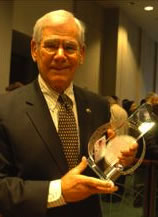
Rod Diridon accepts the US High Speed Rail Lifetime Achievement award.
BREAKING NEWS – The US High Speed Rail Association (USHSR) presented this year's High Speed Rail Awards to Rod Diridon, Dan Richard, and Dr. Anthony Perl at its tenth High Speed Rail Conference in Los Angeles, December 3-5, 2012.
Rod Diridon: lifetime of transportation leadership
The Lifetime Achievement award acknowledges individuals who have spent years dedicated to improving transportation options in America. Diridon has served as executive director of the Mineta Transportation Institute, and he has chaired more than 100 international, national, state and local programs, most related to transit and the environment.
Mr. Diridon was appointed by Governors Davis and Schwarzenegger, in 2001 and 2006, respectively, and to the California High Speed Rail Authority Board, of which he is chair emeritus.
“Heroes of HSR” award for Dan Richard
Dan Richard was presented the Heroes of High Speed Rail Award, given to individuals who have made a major contribution bringing high speed rail to America. He is Chairperson of the California High Speed Rail Authority, and has been a principal of Dan Richard Advisors since 2010. Mr. Richard was an elected member of the San Francisco Bay Area Rapid Transit District from 1992 to 2004, where he served twice as president of the Board.
Anthony Perl earns Transport Revolution award
Anthony Perl was presented the Transport Revolution Award, given to those who advocate for sweeping change in American transportation. Dr. Perl is an international authority on transportation and energy, and on their interconnection. He is Director of the Urban Studies Program at Simon Fraser University in Vancouver, British Columbia. Dr. Perl is a book author who is widely published in many journals and professional publications.
Award recipients hailed as “visionaries”
“On behalf of the US High Speed Rail Association membership, we are proud to honor these great leaders,” said USHSR President Andy Kunz.“It's visionaries like these who change society for the better.”
USHSR's High Speed Rail Awards honor individuals who have the vision and courage to help bring high speed rail to America. The award recipients range from visionaries to those at the forefront of the movement to bring 21st-century transportation to America.
Board Profile: Jean-Pierre Loubinoux
Donna Maurillo, MNTRC Director of Communications
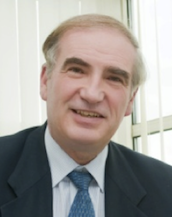
Jean-Pierre Loubinoux
Director-General, International Union of Railways
Jean-Pierre Loubinoux has served as director-general of the International Union of Railways (UIC) since 2009. He contributes his long years of experience and knowledge about transportation – especially rail. MTI is honored to have him serving on its Board of Trustees.
Global rail experience leveraged
A graduate of the Ecole Centrale Paris, he worked at the French Foreign Trade Delegation to Hong Kong before joining French railways SNCF in 1978. There, he held various responsibilities including Director of the SNCF General Delegation in North-America and Chief Executive of French Railways UK Ltd in Britain. He then joined the SNCF freight department where he successively managed the coal-steel business unit and the human resources, data processing and finance departments.
In 2001, he was appointed chief executive of SNCF Freight International, and for the next eight years, he served as chairman and CEO of SNCF International and SNCF director of international development.
In March 2009, Mr. Loubinoux was appointed director-general of the International Union of Railways (UIC), the worldwide association representing the rail sector and encompassing 200 railways across all the continents. His mandate was renewed at the June 2010 UIC General Assembly in Tokyo and is set to run until March 2013.
Expertise sought by many
Mr. Loubinoux holds responsibilities in a large number of institutions and associations, including French foreign trade advisor and chairman of the Transport Committee, chairman of the Medef International France-Argentina Committee, vice-chairman of the Ecole Centrale Association, chairman of AFFI (the French association of railway engineers and managers), member of the Chartered Institute of Transport, and member of the board of the US High Speed Rail Association.
He has been awarded the Legion of Honour and is a holder of the Silver Medal of the French Ministry of Equipment, Transport and Tourism. In September 2011 he received also his insignia as Commander of the French National Order of Merit – one of the highest decorations in France along with the Legion of Honour.
HSR panelist at upcoming TRB meeting
MTI is especially proud that Mr. Loubinoux will be a panelist at its high-speed rail workshop, co-sponsored by the Transportation Research Board. That is set for Sunday, January 13, 2013, from 8:30am-4:30pm in the Omni Shoreham Hotel’s Blue Room, Washington DC. Reservations may be made via the TRB web site.
Li-ion battery reuse model nears completion
Charles Standridge, PhD, Assistant Dean, Padnos College of Engineering and Computing
GVSU NEWS – Faculty members, graduate students, and staff from Grand Valley State University (GVSU) in the School of Engineering and the Michigan Alternative and Renewable Energy Center (MAREC) are continuing their research regarding remanufacturing, repurposing and recycling electric batteries from transit vehicles such as buses.

Discarded or returned phone batteries can be remanufactured and redistributed.
Source: Cadex
With its focus on lithium-ion batteries, the team is working in partnership with Sybesma’s Electronics, a third-generation family owned business in Holland MI, to insure that this work has industrial applications.
Improving the economics of sustainable transit operation
The overarching goal is to provide better economic value to transit operators who use electric vehicles, and thus to increase sustainability of public transit. The project has four major components:
- A dynamic simulation model of the supply, demand, and economics of lithium-ion battery remanufacturing, repurposing, and recycling
- Remanufacturing process development with emphasis on safe handling of batteries
- Recycling process development and economic analysis
- Repurposing demonstration development
The first version of the dynamic simulation model should be complete by the end of this year. The model incorporates a range of demand projections extracted from the published literature. It considers the apparent shift in demand in the lithium-ion battery market toward stationary storage applications. Regarding economics, the model takes into account recycling costs versus remanufacturing costs and benefits.
Safety a key issue in li-ion battery remanufacturing
Safety is the single most significant issue in lithium-ion battery remanufacturing. Battery packs must be taken apart, reassembled and tested. This testing involves repeatedly charging and discharging the batteries. To facilitate this process, the research team worked closely with Sybesma’s Electronics to design and build a work bench that meets safety requirements. The bench completely encloses the battery pack and allows the operator to drop the pack into a sealed container instantly if a hazardous incident occurs.
Recycling and repurposing activities are in their initial stages. Equipment necessary to disassemble the lithium-ion batteries is on order. The needed batteries are in-hand. The disassembly task is focused on determining the aftermarket value of the battery materials.
Secondary-use applications demonstrated
Goals of the repurposing demonstration task include showing the effectiveness of using transit vehicle batteries for aftermarket secondary storage applications, as well as analyzing the economics of such applications.
For more information, email or call Charlie Standridge at (616) 331-6260.
Rutgers University News
Robert B. Noland, PhD, Director, Voorhees Transportation Center
Taxi GPS data provides traffic insights
The Voorhees Transportation Center has created a research project to leverage valuable data from taxi GPS systems. The project goals are twofold: first, to use GPS data from taxis to understand actual taxi travel characteristics, such as the busiest origins and destination, and second to understand overall network conditions using average travel speeds, distances, and times obtained from the data. Research team members include Eric J. Gonzales, PhD; Ci Yang; Ender F. Morgul; and Kaan Ozbay, PhD.
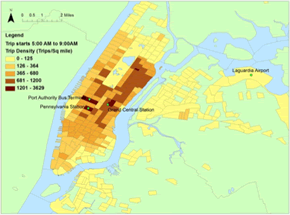
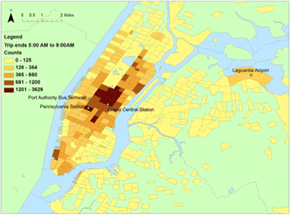
Sample density of taxi pick-ups (top) and drop-offs (bottom) in New York City..
Source: NYCDOT.
Congestion times, locations revealed
Taxi traffic accounts for almost 12% of the total street traffic in New York City. This means the GPS data from taxi trips is a valuable resource to understand citywide traffic conditions. Traditional traffic surveillance methods, such as loop detectors or closed circuit video cameras, are expensive to deploy and can measure only traffic flows, speeds, and densities at fixed locations in the network. However, GPS data from the linked origins and destinations of taxi trips provide detailed information about where traffic congestion occurs and at what times of day.
Travel demand patterns studied
The GPS data from New York taxis consist of nearly 40 billion data points per year, which provide sufficient detail to support analysis of specific spatial and temporal variations in taxi use and traffic conditions. All together, these data show patterns of travel demand. Maps of taxi trip origin and destination densities from a sample of data during the morning peak, for example, show the concentration of trips starting at major transit hubs and ending in Manhattan’s busiest business districts.
Travel times, traffic delays predicted
The abundance of data is also useful for comparing the characteristics of individual trips. Therefore, an additional aspect of this project is to analyze the reliability of taxi travel times for specific origin-destination pairs compared to other modes of travel, such as bus and rail transit. Using Google Maps API, a tool is in development to provide estimated transit travel times corresponding to actual observed taxi trips. Ultimately, the data set will provide insights for where and when traffic congestion has the greatest detrimental effect on travel times for taxis. This might also indicate delays for other road users, including buses.
The methods developed as part of this study can be used to study demand patterns in other cities with high taxi use. The methods for using GPS data to estimate traffic conditions and travel time variability on the road network may be applied to data from other types of vehicle fleets as well.
Understanding bus transit driver availability
RUTGERS NEWS –Transit agencies must employ a sufficient number of transit vehicle operators to meet their scheduled service requirements and to account for unforeseen absences, such as illness. To do so, the agencies employ extraboard operators (on-call backups) to account for these unexpected situations and ensure that service is not interrupted. Transit agencies have a burden to meet minimum service requirements for day-to-day operations. However overestimating the number of extraboard operators can also have a significant cost for these usually cash-strapped transit agencies. The Voorhees Transportation Center is investigating a way to address this issue. The research team includes Kaan Ozbay, Ender F. Morgul, Eric J. Gonzales, Hani Nassif, and Ozlem Cavus.
Goal: reliable bus service at minimum cost
In this study funded by the Mineta National Transit Research Consortium, we are investigating the transit agencies’ day-to-day extraboard management problem of adequately managing supply while maintaining an acceptable level of service.
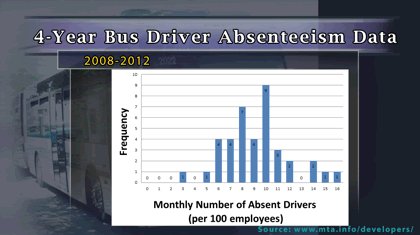
Monthly number of absent transit drivers.
Source: www.mta.info/developers.
The main research objective is to create an extraboard management plan primarily for transit agencies – such as New Jersey Transit, New York Metropolitan Transportation Authority, and Rutgers University – to properly and efficiently allocate their personnel throughout their respective bus transit systems.
The goal is to help the transit agencies provide reliable bus service throughout the system, but to do so efficiently and at a minimum possible cost. The observed demand and supply data required for the model validation can be obtained from the transit agencies in the New York/New Jersey area that have already deployed advanced technologies such as smart cards, on-board GPS, and other emerging transit fare collection and asset tracking technologies.
Reliability and risk assessed
Stochastic mathematical models that can adequately capture the complex structure of the agencies’ decision making processes through observed data are employed to develop an extraboard management plan that takes into account various reliability and risk measures. Recently, the Rutgers research team has completed extensive work to develop similar probabilistic mathematical models required to develop an extraboard management plan for emergency evacuation conditions. These models are now being modified and applied to non-evacuation conditions where risk and reliability measures can be substantially different from those for emergency management operations.
Reduced costs, better management play key roles
The research team also plans to implement these models in a user-friendly computer tool that enables decision-makers to easily create various scenarios and to conduct “if-then” scenarios for quick decision making. The end product of this study will be leveraged to help develop several recommendations that transit agencies can easily adopt to reduce operating costs with more effective extraboard management strategies.
San Jose State University News
MTI researchers publish transportation security textbook, and other research news
Karen Philbrick, PhD, Director of Research
New textbook by MTI security experts.
Dr. Frances Edwards, MTI’s Deputy Director of the National Transportation Security Center, and MTI Research Associate Dan Goodrich recently published the textbook Introduction to Transportation Security.
Their approach emphasizes the important connection and integration between “security” and “emergency management” and pays close attention to theory, practice, and application. This book stresses the importance of reducing the risk of disaster from the beginning concept and design through operation and maintenance of the nation’s transportation systems.
TRB annual meeting to feature MNTRC research
Twelve MTI/MNTRC research papers were selected for presentation at the 2013 Transportation Research Board Annual Meeting. Among them:
- Dr. Asha Weinstein Agrawal: What Do Americans Think About Federal Tax Options to Support Public Transit, Highways, and Local Streets and Roads? Results from Year 3 of a National Survey. (MNTRC Project 1128)
- Dr. Jeff Brown will make two presentations: Understanding the Effects of Systemwide Transit Network Restructuring in a Decentralized US Metropolitan Area on Transit Agency Ridership and Performance: A Case Study of StarMetro in Tallahassee, Florida, and How Does Restructuring from a CBD-Focused Transit System to a Decentralized Transit System Affect Transit Riders and Their Accessibility to Destinations? A Case Study of StarMetro in Tallahassee, Florida. Both are based on MNTRC Project 1102.
- Dr. Matthew Holian: Measuring the Value of Transit using Survey and Voting Data. (MNTRC Project 1105)
MNTRC presence strong at other conferences
The MNTRC travel grant program enables many researchers to present work at a variety of professional conferences during the year. Though most of the currently funded research is still in progress, many of the project teams have preliminary results that have reached larger audiences.
For example, Dr. Robert Noland and his team presented at the Annual Meeting of the Association of Collegiate Schools of Planning where they discussed The Impact of Transit-Oriented Development on Social Capital, Physical Activity, and Environmental Conditions(MNTRC Project 1145). Dr. Susan Shaheen and her team will present the findings of their study on Public Bikesharing in North America: Understanding Impacts, Business Models, and Equity Effects of Bikesharing Systems During Rapid Industry Expansion (MNTRC Project 1131) at the International Bike Share in the Spring of 2013. Additional research results either have been or will be presented at the American Public Transportation Rail Conference; the American Railway Engineering and Maintenance-of-Way Association (AREMA); and the Rail-Volution 2012 Conference.
Students from 13 high schools attend Summer Transportation Institute
Peter Haas, PhD, Director, MTI Education Programs
High school students gain field experience with transportation management issues.
MTI’s 2012 Summer Transportation Institute (STI) brought together a diverse group of students from 13 high schools in and around San Jose, Calif. Led by STI Program Director Rosaleen “Roz” Zisch, this year’s curriculum went “green,” eliminating or reducing paper. This meant the students final projects were given as PowerPoint presentations.
Academic standards upheld despite budget cuts
Despite necessary budget reductions, the Institute maintained its usual academic standards and hosted six professional guest speakers representing several types of transportation. The class also walked to San Jose’s Diridon Metro Station for a firsthand discussion of its future from the facility’s namesake, Rod Diridon, who is also executive director of the Mineta National Transit Research Consortium.
Students tour BART station under construction
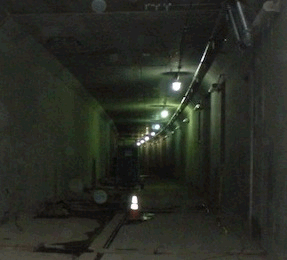
Students could walk this transit tunnel under construction.
The class received free Valley Transportation Authority (VTA) passes that allowed the students to travel by light rail and bus to Lake Elizabeth in Fremont. There, several Bay Area Rapid Transit (BART) engineers treated the group to a VIP tour. This included an underground walk along the tunnel that is key to constructing the new Warm Springs Station. The subway is about 1.25 miles long, or about 20% of the extension into Santa Clara County. Wearing special helmets and vests for safety, the students traveled down a narrow stairway to enjoy a unique view of the complex construction necessary for this project.
Garrett Morgan Competition underway
Donna Maurillo, MSTM, Director, Communications & Technology Transfer
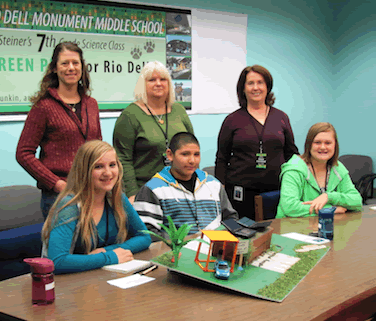
The competition team from Monument Middle School in Rio Dell CA with teacher Sheryl Steiner (standing center).
Will tomorrow’s transportation use the power of wind or sun? Can algae produce a viable alternative to gasoline? Could a flying bus make commuting easier? And how can transit services be delivered more profitably?
Those are some of the questions addressed during the annual Garrett Morgan Sustainable Transportation Competition. MTI works in concert with California’s DOT (Caltrans) to plan and organize this curriculum that challenges middle-school students to think creatively about solving transportation problems. Each student receives a free workbook from MTI, which provides the entire curriculum, including quizzes and thought-provoking questions. Then the student teams create a project that they demonstrate during a live streaming video broadcast.
Students are excited to be introduced to transportation leaders during the broadcast, including Transportation Secretary Ray LaHood, retired Transportation Secretary Norman Mineta, Caltrans director Malcolm Dougherty, AASHTO CEO John Horsley, APTA CEO Michael Melaniphy, MTI executive director Rod Diridon, and others.
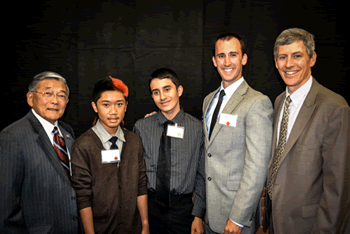
Garrett Morgan award winners with Secretary of Transportation Norman Mineta and MTI Board Chair Steve Heminger.
Innovation, teamwork and presentation count
Each team is judged not only on its project, but also on its presentation skills, professional demeanor, teamwork, and other essential factors. The winning school receives a $500 cash award. Second- and third-place teams receive $300 and $200, respectively. All three receive a plaque, and participants from all teams receive certificates personally signed by the Secretaries.
A few recent winners have included a team demonstrating a solar car that recharges at night with stored energy from a solar-powered garage. Another winning team presented a plan for a more efficient and profitable urban bus system, and another created a video public service announcement that boosted the attractiveness of riding transit.
Transcripts from previous competitions available online
Teams already are working on their projects, with the broadcast set for early April 2013. Transcripts and streaming videos from previous Garrett Morgan competitions are available at no cost.
MOCs help build international cooperation
The Mineta Transportation Institute is playing a role in helping to create more cooperation among nations. Earlier this year, MTI hosted Dr. Wenjeng Jia, who came to San Jose State University to learn more about US transit systems. His home base is in Beijing at the China Academy of Transportation Studies (CATS).
MTI organized tours for him at several Silicon Valley transit agencies, such as Bay Area Rapid Transit (BART), Caltrain, the Bay Bridge Authority, and Valley Transportation Authority. He also traveled to Washington DC to meet with officials at the American Public Transportation Association (APTA), the US Department of Transportation, and other entities.
Spain, Italy, Sweden, Japan take part
MTI will other visitors, as well. Current Memoranda of Cooperation (MOC) are with Spain’s University of Cordoba and Sweden’s KTH Royal Institute of Technology. Others are in negotiation, including with Italy’s University of Pisa and Japanese Railway East’s research laboratory.
“Spain is not a wealthy country,” said Rod Diridon, executive director for MTI and MNTRC, “but the government has shown how to build and operate one of the best high-speed rail systems in the world. And it makes money! We hope to learn from them.”
Sustainable transportation lags in US
MTI is especially enthusiastic about MOCs because so many other countries are ahead of the US in terms of integrating sustainable transportation.
Diridon said, “The US may have the best highways and freight rail, but the country must catch up with the world’s most sustainable passenger programs. They can show America how to modernize transportation systems and make them more efficient, especially in upgrading to electrical power to address climate change. The US can no longer think it is the best in everything. In some areas, it must learn from the others.”
UDM holds annual transit camp
Pamela Rhoades Todd, Principal Investigator, Summer Transit Camp
UNIVERSITY OF DETROIT MERCY NEWS – University of Detroit Mercy held its sixth Transit Summer Camp, in which students from the greater Detroit area spend a week at the University exploring transportation engineering as a career. They also learn how transit systems affect their communities. The summer program focuses on underrepresented students, with collaboration among university, corporate and government partnerships.
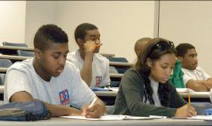
Students give up a week of summer vacation to learn about transit.
Traffic, transit problems studied
Hands-on projects, guest speakers from industry, field trips, and expert university input from civil and manufacturing engineers provided information that opened new career ideas for the students. Specific topics included traffic control management, vehicle infrastructure integration, social justice in transportation and flow of transportation concepts, identification and innovative solutions to transit and paratransit problems, the history of transit, and workforce development issues. Each morning, students heard from corporate and university speakers, and in the afternoon, they worked with the LEGO SMART MOVES Curriculum and Challenge.
Diverse speakers and perspectives provided
- Pamela Rhoades Todd, Director of Pre-College Programs, College of Engineering and Science, welcomed the students and gave them an overview of the Department of Transportation grant and the objectives of Transit Camp.
- Tiffany Gunter, representing the Southeast Michigan Council of Government, explained current rail initiatives, including the funding needs and the politics of starting projects.
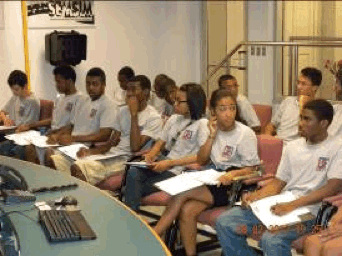
Students enjoy their field trip to the Road Commission for Oakland County.
- Peter Guenther, a high school teacher, presented lessons from the LEGO SMART MOVES Curriculum. These hands-on activities directly relate to the lectures. Students designed and programmed robots, and competed on the final day of class.
- Christina Heximer and members of the Detroit Collaborative Design Center spoke about “Architecture of Urban Planning and Transportation,” including transportation flow from the perspective of urban planning and land use.
- Dr. James Lynch, UDM professor, discussed the civil engineering profession. This lecture was the cornerstone about all fields of engineering.
- UDM faculty member Dr. Alan Hoback presented “Social Justice in Transportation.” It included a lively discussion about political and social influences that can affect transportation decisions.
- Cheryl Gregory from Spalding DeDecker spoke about perspectives from a traffic engineer. She brought equipment that allowed students to test maglev transit and how velocity and mass can affect an accident.
- A field trip to the Road Commission for Oakland County is always the highlight. This is a professional facility that shows how traffic is tracked and controlled. Presenters Dawn Bierlein and Danielle Deneau provided an overview of current and future technology that helps control traffic safety and flow.
- Dr. Utpal Dutta of the UDM faculty demonstrated a computer simulation that helped students understand “Traffic Flow at Signalized Intersections.” Students left this session thinking about important intersections in their neighborhoods and why many of them have problems.
Program participants conducted final testing of their robots and final tweaks to their PowerPoint presentations for the closing ceremony and competition.
Distinguished seminars discuss mobility issues
Hualiang (Harry) Teng, PhD, Associate Professor, Civil and Environmental Engineering
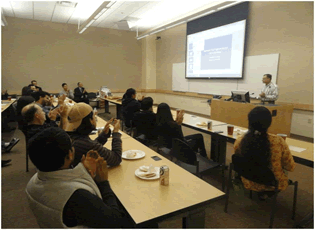
Seminar given by Dr. Edward Neumann
UNLV NEWS –The University of Nevada, Las Vegas (UNLV) presented two distinguished seminars with the support of MNTRC and the Institute of Transportation Engineers Intermountain Section, Nevada Chapter.
The first seminar – “Railroads, Civil Engineering, and Nation Building” – was given by Dr. Edward Neumann, a senior faculty specialized in transit technology in transportation engineering of the Civil Engineering Department at UNLV.
High-speed rail rooted in history
In his presentation, Dr. Neumann provided an historic overview of railroad construction in the US, from the first railroad to the formation of a national railroad network. He provided the background of railroad technology development, the financial mechanism for construction, the engineering characteristics of initial railroads, the manpower required to construct the railroads, including Chinese participation, how some railroads failed, and the people who became wealthy from railroad construction.
The discussion had implications regarding high-speed rail currently under construction in the US. For example, what should be the financial mechanism to fund high-speed rail? Would private investment always be profitable? How could railroad engineering firms work together? These issues are relevant to current high speed rail construction because it is critical to avoid the mistakes from the past.
Graduates, undergrads and faculty attend
Approximately 50 graduate and undergraduate students and faculty from various engineering departments attended the seminar. It was an encouraging success for this first seminar in the series.
In addition to the support from MNTRC, other student organizations also participated in this seminar, including AREMA Student Chapter at UNLV, ITE Student Chapter at UNLV, and ASCE Student Chapter at UNLV. The students from the CEE 495/695 Railroad Engineering course also attended.
Metropolitan planning, transit, and street operations covered
The second distinguished seminar was given before an audience of 50 people by Ms. Tina Quigley, general manager of the Regional Transportation Commission (RTC). RTC performs three primary functions: metropolitan planning organization in Southern Nevada, Transit service, and freeway and surface street operations. RTC is the only agency combining these three major functions under one roof, making them easier to integrate and coordinate.
Ms. Quigley introduced the contributions RTC made in each of three areas, with significant coverage on transit service in southern Nevada. By presenting the bus rapid transit (BRT) map, she demonstrated how BRT has evolved and expanded to serve the entire metropolitan area. The audience also was interested in the likelihood of constructing a light rail line in the valley, particularly along the Maryland Parkway connecting Las Vegas downtown to Las Vegas Airport and running through a variety of land uses such as university, shopping mall, hospital, etc.
-
Contact Us
San José State University One Washington Square, San Jose, CA 95192 Phone: 408-924-7560 Email: mineta-institute@sjsu.edu

